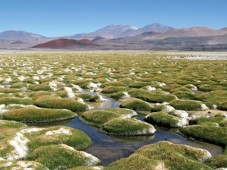
The wetlands of the high Andes provide fresh water for more than 100 million people, support important wildlife, and are a significant carbon sink. Unregulated and unsustainable development threatens these habitats and their capacity to support people and wildlife. BirdLife Partners in Argentina, Bolivia and Ecuador are working with local communities to ensure conservation and sustainable use of these wetlands.
High altitude wetlands cover 3% of the planets land surface (Maltby and Immirzi, 1993) but sequest 30% of global carbon from terrestrial ecosystems (Gorham, 1991, Blodau, 2002). Tropical Andes ecosystems are however at risk from climate change, with changing temperatures and rainfall patterns likely to influence habitats and the ecosystem services they supply (Urrutia and Vuille 2009).
BirdLife International and its Partners in Argentina, Bolivia and Ecuador are leading a programme to conserve and manage the wetlands of the High Andes for the mutual benefit of people and biodiversity. These wetlands are home to a range of endemic and threatened bird species (Caziani et al. 2007, Rosselli and Stiles 2012), and are vital links in the chain of sites used by migratory birds (Bildstein 2004).
The High Andean Wetlands Regional Programme has established a conservation and management network across the region, evaluated and promoted awareness of the environmental services provided by the wetlands, and involved local communities in conservation and the sustainable use of the resources the wetlands provide. In collaboration with other conservation NGOs in the region, projects have been implemented in the three BirdLife Partner countries and in Peru.
A new protected area has been declared to protect the breeding area of the Critically Endangered Hooded Grebe Podiceps gallardoi. Other protected areas have been extended; conservation action plans have been improved and implemented at key sites. New and unpublished information and expert knowledge about the importance of high Andean wetlands for migratory birds has been gathered: it has been made available to conservation practitioners throughout the region; and similar projects are being developed in Colombia and Chile.
This case study is taken from ‘The Messengers: What birds tell us about threats from climate change and solutions for nature and people’. To download the report in full click here.
Related Case Studies in other sections
Related Species
References
Compiled: 2015 Copyright: 2015
Recommended Citation:
BirdLife International (2015)
Conserving the High Andean wetlands for birds and people.
Downloaded from https://datazone.birdlife.org/sowb/casestudy/conserving-the-high-andean-wetlands-for-birds-and-people on 22/12/2024